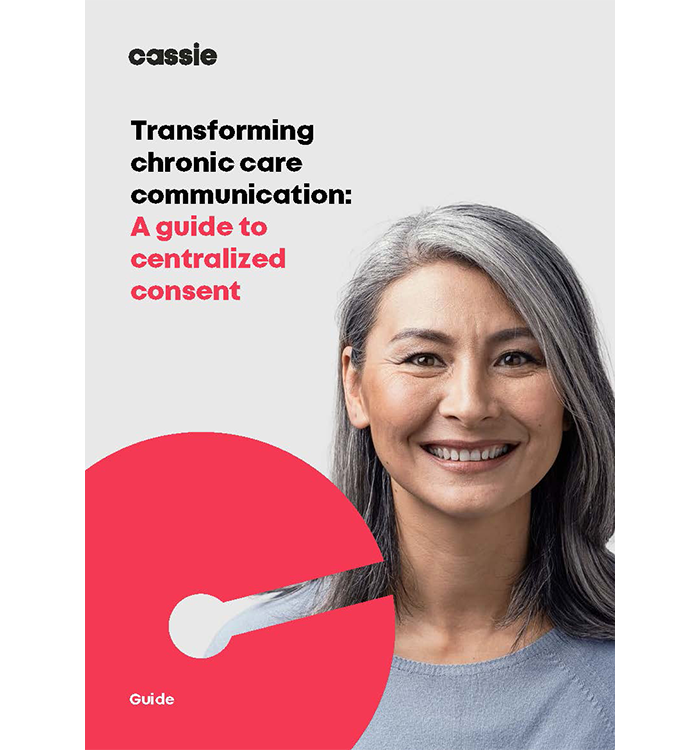5 ways disconnected consent is impacting patient experiences
Posted: August 28, 2023
The patient experience in healthcare is about more than just quality medical care—it’s also about trust, transparency, and communication.
One critical aspect of patient-provider interactions that often goes overlooked is consent.
When consent management processes are disconnected or poorly managed, it can have a detrimental impact on patient experiences.
With many healthcare providers managing multiple tech stacks across siloed teams, it’s no surprise that individual user consent and preferences can get misplaced or incorrectly attributed.
Systems have different terminology and processes, leading to errors and the potential risk of fines from malpractice when it comes to handling personal data and communication.
We’re exploring five ways disconnected consent is undermining patient experiences and what healthcare organizations can do to address these issues.
- Lack of informed decision-making
- Privacy concerns
- Lack of personalization
- Complexity and confusion
- Fragmented communication
- The path to connected consent
1. Lack of informed decision-making
Patients are often presented with consent forms or information at the last minute, leaving little time for them to make informed decisions about their care.
Impact on patient experience: Patients may feel rushed, anxious, or uninformed when asked to provide consent under pressure, leading to a diminished sense of control over their healthcare journey.
Solution: Implement a process that ensures patients receive detailed information about their options well in advance, allowing them to make informed decisions at their own pace.
2. Privacy concerns
Patients’ sensitive health information is often shared without their full understanding or consent.
Impact on patient experience: Patients may feel that their privacy is not adequately protected, eroding trust in the healthcare system.
Solution: Clearly communicate how patient data will be used and shared, and obtain explicit consent for each use, ensuring compliance with data privacy regulations like HIPAA, CCPA. and specific state legislation like Washington’s My Health, My Data act.
3. Lack of personalization
Consent processes that do not consider patients’ individual preferences and needs create a one-size-fits-all approach.
Impact on patient experience: Patients may feel that their unique concerns and values are disregarded, leading to frustration and dissatisfaction.
Solution: Tailor consent discussions to each patient’s circumstances, addressing their specific questions and concerns to create a more personalized experience. Use consent management platforms that can attribute granular preferences to a data subject to inform system usage and tailor communications.
4. Complexity and confusion
Complex medical jargon and lengthy consent forms can leave patients feeling overwhelmed and confused.
Impact on patient experience: Patients may struggle to understand the implications of their decisions, leading to anxiety and uncertainty.
Solution: Simplify consent forms and explanations, using plain language and visual aids to enhance understanding. This is just as true for your general communication as it is for documentation and policies, like your privacy policy or terms and conditions.
5. Fragmented communication
When consent processes are not integrated with overall patient communication and the organization’s overarching tech stack, patients may receive conflicting or confusing information.
Impact on patient experience: Patients may become frustrated by inconsistencies and a lack of coordination in their care, leading to a breakdown in trust.
Solution: Ensure that consent processes are seamlessly integrated with the broader patient communication strategy, providing consistent and coherent information throughout the patient journey. Ideally, choose a consent management platform that can centralize consent across systems, devices and stakeholders.
The path to connected consent
To enhance patient experiences and build trust, healthcare organizations must prioritize connected consent processes. This involves:
Timely and transparent communication: Providing patients with clear, understandable information about their care options and obtaining consent well in advance.
Privacy protection: Safeguarding patient data and ensuring that its use is explicitly consented to.
Personalization: Recognizing the individuality of each patient and tailoring consent discussions accordingly.
Simplicity: Simplifying consent forms and explanations to reduce confusion.
Integration: Coordinating consent processes with broader patient communication strategies to ensure consistency.
By addressing these key areas and embracing connected consent practices, healthcare organizations can empower patients to make informed decisions, protect their privacy, and enhance their overall healthcare experience.
Ultimately, connected consent is not just a legal requirement; it’s a fundamental element of patient-centered care that fosters trust, transparency, and satisfaction in healthcare interactions.

Download: Transforming chronic care communications – A guide to centralized consent
Effective communication is integral for chronic care centers but legacy systems and disparate technology stacks present challenges.
In this guide, we look at:
- Overview of the importance of effective communication in chronic care
- The role of centralized consent in improving chronic care communication
- Centralized consent: A solution overview
- 6 steps to implement centralized cons

